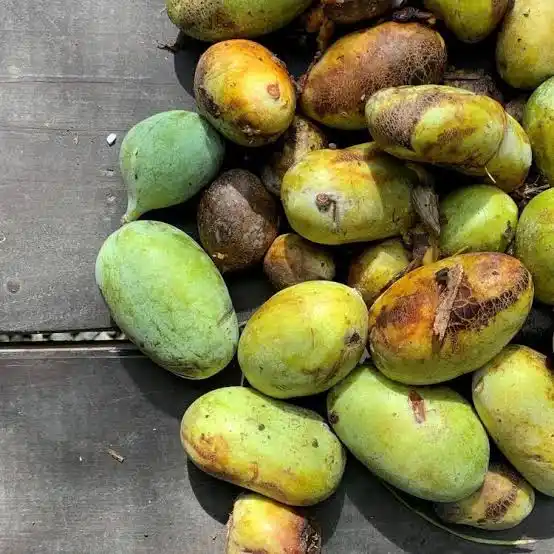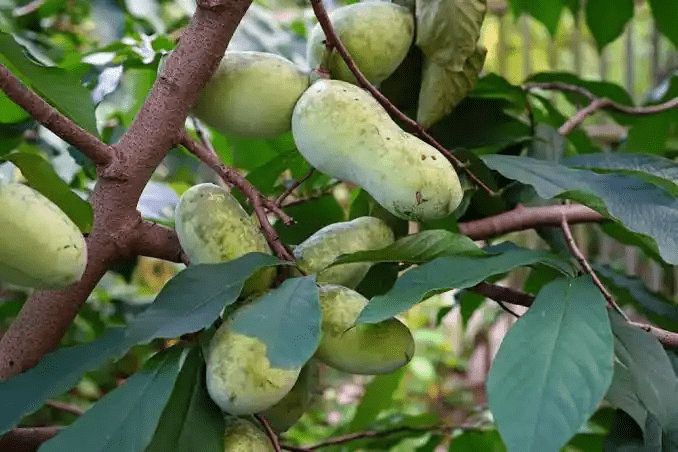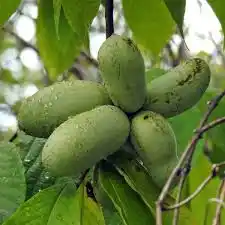Pawpaw, scientifically known as Asimina triloba, is a fascinating and unique fruit-bearing tree native to North America. Also commonly referred to as the American pawpaw, custard apple or poor man’s banana, this deciduous tree belongs to the Annonaceae family. With its tropical flair and custard-like fruit, the pawpaw stands out as an unusual addition to the temperate forests of the United States.
The pawpaw tree typically reaches heights of 12 to 20 feet, with large, elliptical leaves that can grow up to a foot in length. Inconspicuous maroon flowers emerge in the spring, attracting pollinators such as beetles, flies, and carrion beetles due to their somewhat foul odor.
Interestingly, the pawpaw tree is not self-pollinating, and cross-pollination is often facilitated by these unique pollinators.
The fruit of the pawpaw is a highlight of this tree, both in terms of appearance and taste. Pawpaws are the largest edible fruit native to North America, with a greenish-yellow exterior and a creamy, custard-like interior.
The flavor is a delightful combination of tropical notes, often likened to a blend of banana, mango, and melon. The texture is smooth and custardy, making it a distinct and enjoyable treat.
Pawpaws have been a part of Native American and early American settlers’ diets for centuries. Today, they are experiencing a resurgence in popularity, with enthusiasts appreciating their unique taste and the tree’s role in promoting biodiversity.
While pawpaws are not as commonly found in commercial markets as more mainstream fruits, they can sometimes be sourced at local farmers’ markets or specialty stores.
Cultivating pawpaws can be challenging, as they have specific requirements for optimal growth. They thrive in rich, well-drained soils and prefer a partially shaded environment, mimicking the conditions of their native woodland habitats.
Due to their limited shelf life and delicate nature, pawpaws are best enjoyed fresh and are not as well-suited for long-distance transportation.
In addition to their culinary appeal, pawpaws have also garnered attention for their potential health benefits. They are a good source of essential nutrients, including vitamins A and C, as well as minerals like magnesium and potassium.
Some traditional medicine practices also attribute various medicinal properties to pawpaw, although more scientific research is needed to substantiate these claims.
The pawpaw tree, with its lush foliage and distinct fruit, adds an element of tropical charm to temperate climates. As interest in native and unique fruits grows, the pawpaw stands out as a symbol of biodiversity and a delicious reminder of the diverse flora found in North America.
Whether enjoyed fresh, incorporated into recipes, or simply appreciated for its ornamental value, the pawpaw tree continues to captivate those with a taste for the extraordinary.
The Botanical Description of Pawpaw
1. Overview: Pawpaw, scientifically known as Asimina triloba, is a deciduous fruit tree belonging to the Annonaceae family. Known for its distinctive tropical flavor, Pawpaw is native to North America and is often referred to as the “poor man’s banana” or “custard apple.”
2. Tree Characteristics: Pawpaw trees typically reach heights of 15 to 30 feet, featuring large, elliptical leaves that can span up to a foot in length. The tree’s structure is somewhat pyramidal, with a straight trunk and drooping branches.
3. Flowers and Fruits: The flowers of Pawpaw are unique, with a dark maroon color and a complex, foul odor that attracts flies for pollination. The fruits that follow are green, turning yellow when ripe, and can weigh anywhere from 5 to 16 ounces.
4. Leaves and Bark: Pawpaw leaves are simple, alternately arranged, and have an oblong shape. They turn a vibrant yellow in the fall, adding to the tree’s ornamental value. The bark is smooth and brownish-gray, contributing to the overall aesthetic appeal of the tree.
5. Growth Habits: Pawpaw trees prefer well-drained, slightly acidic soils and are often found in the understory of woodlands. They exhibit a clonal growth habit, with new shoots sprouting from the base of the tree.
6. Pollination Mechanism: Pawpaw trees are self-incompatible, requiring cross-pollination for fruit production. Flies, attracted by the peculiar odor of the flowers, play a crucial role in the pollination process.
7. Adaptability: Pawpaw trees are hardy and adaptable, capable of thriving in a variety of soil types. They are well-suited to temperate climates and can be cultivated in regions with cold winters.
8. Seasonal Changes: The Pawpaw tree undergoes noticeable changes throughout the seasons. In spring, it boasts attractive maroon flowers, followed by the emergence of large leaves. In summer, the tree bears fruit, and in fall, its foliage turns a brilliant yellow before shedding.
The Geographic Distribution of Pawpaw
1. Native Range: Pawpaw is native to the eastern United States, primarily found in the region stretching from the Gulf Coast to the Great Lakes and as far west as Nebraska. It thrives in the understory of hardwood forests.
2. Cultivation Outside Native Range: While native to specific regions, Pawpaw has been successfully cultivated beyond its natural range. Orchards and individual trees can be found in various states, as well as in parts of Canada.
3. Soil Preferences: Pawpaw trees exhibit adaptability to a range of soils, but they thrive in well-drained, fertile soils. They are often found in river valleys and areas with loamy or sandy soils.
4. Climatic Conditions: Pawpaws are well-suited to temperate climates, with a preference for areas with cold winters and warm, humid summers. They are less common in regions with extreme heat or arid conditions.
5. Natural Habitats: In their native habitats, Pawpaw trees are integral to the ecosystems, providing food for wildlife and contributing to the biodiversity of the understory. They are often found in association with other hardwood trees.
6. Commercial Cultivation: The commercial cultivation of Pawpaw has expanded, with orchards established in regions where the tree is not native. This allows for a broader distribution of Pawpaw fruits to markets and consumers.
7. Home Gardening: Enthusiasts and home gardeners interested in cultivating Pawpaw have contributed to its distribution. With suitable growing conditions, individuals can successfully grow Pawpaw trees in their gardens.
The Chemical Composition of Pawpaw
1. Nutrient Profile: Pawpaw fruits are rich in essential nutrients, including vitamin C, vitamin A, potassium, and dietary fiber. The fruit’s nutritional composition makes it a valuable addition to a balanced diet.
2. Secondary Metabolites: Pawpaw contains various secondary metabolites, including acetogenins, which are bioactive compounds with potential health benefits. These compounds have been studied for their antitumor, pesticidal, and anti-inflammatory properties.
3. Amino Acids: The fruit is a source of essential amino acids, contributing to its overall protein content. Amino acids are vital for various physiological functions in the body.
4. Antioxidant Compounds: Pawpaw is known to contain antioxidant compounds, such as flavonoids and carotenoids. Antioxidants play a crucial role in neutralizing free radicals, contributing to overall health and well-being.
5. Flavor Compounds: The distinctive tropical flavor of Pawpaw is attributed to compounds like isopentyl acetate and hexyl acetate. These compounds give the fruit its unique taste, often described as a blend of banana, mango, and melon.
6. Medicinal Properties: In addition to its nutritional value, Pawpaw has been traditionally used for its potential medicinal properties. Some studies suggest that Pawpaw extracts may have antimicrobial and anti-inflammatory effects, although further research is needed to validate these claims.
7. Practical Uses: Apart from being consumed fresh, Pawpaw can be used in various culinary applications, such as jams, smoothies, and desserts. Its versatility in the kitchen adds to its appeal for those looking to incorporate unique flavors into their meals.
8. Environmental Significance: Pawpaw trees play a role in the conservation of biodiversity, providing habitat and food sources for insects, birds, and mammals. Their adaptability to different soil types and climates makes them valuable contributors to ecosystem health.
Read Also: How to Farm and Care for Indian Mackerel Fish (Rastrelliger kanagurta)
The Medicinal Health Benefits Of Pawpaw (Asimina triloba)

1. Antioxidant Properties: Pawpaw is renowned for its high antioxidant content, helping combat oxidative stress in the body. Antioxidants play a crucial role in neutralizing free radicals, reducing the risk of chronic diseases.
2. Immune System Support: The vitamins and minerals present in Pawpaw, including vitamin C, contribute to a robust immune system. Regular consumption may help the body defend against infections and illnesses.
3. Digestive Health: Pawpaw contains dietary fiber, promoting digestive health by preventing constipation and supporting a healthy gut microbiota. It aids in maintaining regular bowel movements.
4. Cardiovascular Health: The potassium content in Pawpaw supports heart health by regulating blood pressure. Additionally, the fruit’s antioxidant compounds contribute to the overall cardiovascular well-being.
5. Anti-Inflammatory Effects: Some studies suggest that Pawpaw may possess anti-inflammatory properties, potentially alleviating inflammation in the body and reducing the risk of inflammatory conditions.
6. Skin Health: The presence of vitamin A in Pawpaw is beneficial for skin health. It supports the growth and repair of skin tissues and contributes to a healthy complexion.
7. Nutrient Absorption: Pawpaw contains enzymes, such as papain, that aid in the digestion of proteins. This can enhance nutrient absorption and utilization in the body.
8. Weight Management: The dietary fiber in Pawpaw contributes to a feeling of fullness, potentially assisting in weight management by reducing overall caloric intake.
The Methods of Usage to Achieve the Provided Health Benefits Of Pawpaw (Asimina triloba)
1. Fresh Consumption: Enjoy Pawpaw in its natural form by consuming fresh, ripe fruits. This ensures maximum retention of its nutritional content, including vitamins, minerals, and enzymes.
2. Smoothies and Juices: Incorporate Pawpaw into smoothies or freshly squeezed juices. Combine it with other fruits or vegetables to create delicious and nutrient-packed beverages.
3. Culinary Applications: Use Pawpaw in various culinary applications, such as salads, salsas, or desserts. Its unique tropical flavor can add a delightful twist to a range of dishes.
4. Pawpaw Supplements: For those looking to harness specific health benefits, Pawpaw supplements, such as capsules or extracts, are available. These can provide concentrated doses of certain bioactive compounds.
5. Topical Applications: Extracts from Pawpaw leaves or fruits may be used topically for skin-related benefits. However, it’s essential to perform a patch test and consult with a healthcare professional before applying to larger areas.
6. Pawpaw Tea: Pawpaw leaves can be used to make a herbal tea. The tea may have potential health benefits, including anti-inflammatory and antioxidant effects.
7. Homemade Jams and Preserves: Create homemade jams or preserves using Pawpaw fruits. This not only preserves the fruit’s goodness but also provides a tasty spread for various dishes.
8. Culinary Pairing: Experiment with culinary pairings by combining Pawpaw with other complementary ingredients. This versatility allows for the incorporation of Pawpaw into a diverse range of recipes.
The Side Effects Of Using Pawpaw Medicinal Plant
1. Allergic Reactions: Some individuals may be allergic to Pawpaw. Allergic reactions could include itching, swelling, or difficulty breathing. If any allergic symptoms occur, seek medical attention promptly.
2. Overconsumption Issues: Excessive consumption of Pawpaw may lead to digestive discomfort, including diarrhea or stomach cramps. It’s advisable to consume Pawpaw in moderation.
3. Interaction with Medications: Pawpaw supplements may interact with certain medications. Individuals taking prescription medications should consult with a healthcare professional before incorporating Pawpaw supplements into their routine.
4. Unripe Pawpaw Dangers: The latex in unripe Pawpaw contains compounds that can be toxic. Avoid consuming unripe fruits and ensure that any Pawpaw products are derived from fully ripened sources.
5. Pregnancy and Breastfeeding: Pregnant and breastfeeding women should exercise caution when considering Pawpaw supplements. It’s recommended to consult with a healthcare provider to assess potential risks.
6. Blood Clotting: Pawpaw may have antiplatelet effects, potentially affecting blood clotting. Individuals with bleeding disorders or those scheduled for surgery should consult with a healthcare professional.
7. Interference with Blood Sugar Levels: Pawpaw may influence blood sugar levels. Individuals with diabetes or those taking medications to regulate blood sugar should monitor their levels closely.
8. Latex Sensitivity: Some individuals may experience skin irritation or sensitivity to Pawpaw latex. Use caution when handling Pawpaw plants and products, and wear protective gear if needed.
Read Also: A Guide to Growing and Caring for Indian Grass (Sorghastrum Nutans)
The Scientific Research and Studies of Pawpaw

1. Antioxidant Properties: Several studies have investigated the antioxidant properties of Pawpaw, with a focus on compounds like carotenoids and polyphenols. These antioxidants play a crucial role in neutralizing free radicals, contributing to overall health.
2. Anti-Inflammatory Effects: Scientific research has explored the anti-inflammatory effects of Pawpaw. Certain compounds present in the plant may help reduce inflammation, which is a key factor in various chronic diseases.
3. Anticancer Potential: Preliminary studies have examined Pawpaw’s potential as an anticancer agent. Specific compounds, including acetogenins, have been investigated for their ability to inhibit the growth of cancer cells.
4. Gastrointestinal Health: Pawpaw has been studied for its impact on gastrointestinal health. The presence of enzymes like papain may contribute to improved digestion and absorption of nutrients.
5. Antimicrobial Activity: Research has investigated Pawpaw’s antimicrobial properties, exploring its potential to combat various pathogens. This includes studies on the plant’s efficacy against bacteria, viruses, and fungi.
6. Cardiovascular Benefits: Some studies suggest that Pawpaw may have cardiovascular benefits, including the potential to lower blood pressure. Compounds like potassium and antioxidants may contribute to heart health.
7. Wound Healing: Pawpaw has been explored for its wound-healing properties. The plant’s extracts have been studied for their potential to accelerate the healing process of wounds and skin injuries.
8. Neuroprotective Effects: Scientific research has delved into Pawpaw’s potential neuroprotective effects. Compounds found in the plant may have a protective impact on nerve cells, offering potential benefits for neurological health.
The Safety Precautions and Recommendations In Using Pawpaw Medicinal Plant
1. Allergic Reactions: Individuals with known allergies to Pawpaw or related plants should exercise caution. Allergic reactions may include itching, swelling, or difficulty breathing. Discontinue use if any allergic symptoms occur.
2. Moderation in Consumption: While Pawpaw offers various health benefits, moderation is key. Excessive consumption may lead to digestive issues such as diarrhea or stomach cramps. Consume Pawpaw in reasonable amounts.
3. Consultation with Healthcare Professionals: Pregnant and breastfeeding women, individuals with pre-existing medical conditions, or those taking medications should consult with healthcare professionals before incorporating Pawpaw into their routine.
4. Latex Sensitivity: Pawpaw latex may cause skin irritation in some individuals. Use caution when handling Pawpaw plants, especially if latex sensitivity is known. Protective measures, such as wearing gloves, can be employed.
5. Monitoring Blood Sugar Levels: Individuals with diabetes or those taking medications to regulate blood sugar should monitor their levels when using Pawpaw. The plant may influence blood sugar levels.
6. Potential Interactions with Medications: Pawpaw supplements may interact with certain medications. It’s advisable to consult with a healthcare professional, especially if taking medications that may be affected by Pawpaw.
7. Avoiding Unripe Pawpaw: Unripe Pawpaw contains compounds that can be toxic. Ensure that any Pawpaw products or extracts are derived from fully ripened sources to avoid potential health risks.
FAQs About Pawpaw Medicinal Plant
1. Can Pawpaw be consumed during pregnancy?
While Pawpaw is generally considered safe, pregnant women should consult with their healthcare provider before incorporating it into their diet or using supplements.
2. Are there any known drug interactions with Pawpaw?
Pawpaw supplements may interact with certain medications. It’s crucial to inform healthcare providers about Pawpaw use, especially before surgery or when taking medications.
3. How can Pawpaw be included in a daily diet?
Pawpaw can be enjoyed fresh, added to smoothies, or used in various recipes. Its versatility allows for incorporation into salads, salsas, desserts, or even as a standalone snack.
4. Is Pawpaw safe for children?
While Pawpaw is generally safe, it’s advisable to introduce it into a child’s diet in moderation. Parents should monitor for any adverse reactions and consult with a pediatrician if needed.
5. Can Pawpaw supplements be taken for an extended period?
Extended use of Pawpaw supplements should be discussed with a healthcare professional. Regular monitoring and periodic breaks may be recommended.
6. How should Pawpaw be stored for optimal freshness?
Store ripe Pawpaw fruits in the refrigerator to maintain freshness. Use them within a few days to enjoy their peak flavor and nutritional benefits.
7. Can Pawpaw be applied topically for skin conditions?
While some studies suggest potential skin benefits, it’s essential to perform a patch test and consult with a dermatologist before applying Pawpaw topically.
8. Are there any age restrictions for Pawpaw consumption?
Pawpaw can be consumed by individuals of various ages. However, parents should introduce it into a child’s diet based on their developmental stage and dietary needs.
Read Also: Complete Steps in Paper Recycling Guide

